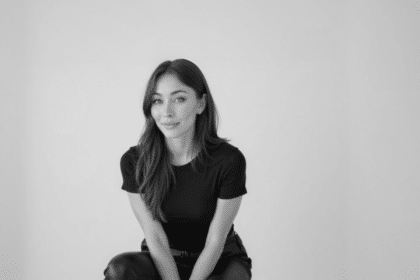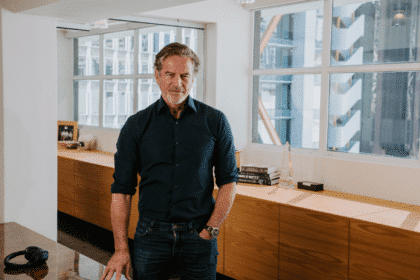In a landscape where impactful communication is paramount, Jess Ridley, founder of By The Way Media and former Sunrise host, is helping professionals navigate the modern media world.
Through her new ON AIR media training short course, she’s empowering businesses of all sizes to make their moments in front of the camera hit the mark, captivate audiences and ensure they don’t become the next Brad Banducci.
As part of B&T‘s ongoing celebration of women in media, we sat down with Ridley to delve into the inspiration behind the self-paced online program, its unique approach to media and presentation training, and her insights into the evolving dynamics of the industry.
B&T: ON AIR delivers media training in a digital, on-demand format. What inspired you to shift from in-person media training to this accessible online model, and how does it better serve today’s media professionals?
Jess Ridley: I’ve been delivering in-person and virtual coaching to CEOs and C-suite executives for the past five years. But as a former television journalist, many times on the road putting a story together, I was more interested in speaking to the airport baggage handler or the checkout person rather than the big boss. But these ground staff were rarely afforded any media or presentation training before being thrown into the spotlight!
I also kept hearing from small business owners and start-up founders who were struggling with time and budget constraints. PR agencies hustle hard around the clock to get their clients in the news cycle, but often their spokesperson lacks the confidence or polish to make the most of it. Then they come to us for training afterwards, instead of before.
I realised we could turn a lot of what we’re teaching in boardrooms across Australia into a flexible, budget-friendly course that allows anyone from big corporations to small teams to access high-quality media training. And it’s scalable for businesses who want to get their leadership teams media-ready! We’re also speaking to top 100 ASX-listed companies about producing customised courses that cover their media policies – almost like an induction-style video series!
B&T: The course emphasises “mastering the modern media landscape”. What are the most significant changes you’ve observed in media consumption and interview dynamics that ON AIR specifically addresses?
JR: The shift to digital is massive. Podcasts, YouTube and social media have become the go-to sources for news, while traditional outlets like TV and print still exist but aren’t the main players anymore.
Interviews are faster, more immediate, and media is fragmented.
Journalists no longer have time for lengthy in-person interviews. Skype calls have become the norm, and there’s rarely time to prepare with a set list of questions. With journalists often working on the fly and with limited resources, there’s a real opportunity for you to take control of the interview and secure the best outcome for your brand.
ON AIR addresses this by teaching you how to communicate confidently across all platforms – from TV to social media to podcasts – and how to stay calm and composed in interviews, no matter how quickly they unfold.
B&T: ON AIR includes input from “top journalists and producers.” How did you curate this expert input, and how does it ensure the course remains practical and up-to-date?
JR: On day one, I approached my friend Allex Conley – who once produced me for a Sunrise Breakfast live cross from the hospital on Mother’s Day with my newborn son Frank. So we’ve been through a lot together in the newsroom environment, and she’s been a gun news producer across channels Seven, Nine and 10. Now, she’s a PR powerhouse, achieving national earned media coverage for major brands and household names.
Like myself, Allex sees the media landscape from both sides and understands the fine balance of managing commercial interests and media relationships. We collaborated for several months on scripts and module development to ensure we got the course content right for both. We also shared this with our close circle of current news editors, journalists and producers to ensure the advice is right up to date with what’s happening in media.
B&T: Many professionals experience media anxiety. How does ON AIR’s structure and content help participants overcome these fears and build confidence?
JR: The best speakers would be lying if they boasted they don’t get nervous. I suffered from mental blanks, a dry throat and a constant fear of stuffing up when speaking to hundreds of thousands of people on the Sunrise Breakfast Show and Today Show each morning.
But you can actually turn nerves into energy for a killer performance. ON AIR focuses on prepping for pressure and building routines to get you calm and confident. Plus, we offer expert tips on handling curveballs, so you’re ready for anything that comes your way.
B&T: How does ON AIR equip individuals to communicate across social media or online?
JR: We have an eight-second attention span these days – which is one second less than a goldfish. And with an eight-second attention span, it’s tough to stand out online. ON AIR teaches you how to use storytelling, clear messaging and vocal variety to make your content memorable.
Whether it’s for social media, an online presentation, or a podcast, we give you the tools to engage and captivate your audience. Think TV and radio techniques, but for every platform!
B&T: ON AIR provides “interactive micro-lessons”. How does this approach enhance learning and retention compared to traditional, lengthy training sessions?
JR: We’ve all sat through a boring induction course or a two-hour workshop on Teams that we tuned out of at the 20-minute mark. Online learning has to be engaging. It has to be interesting. That’s why we threw a lot at the production of this course to make it almost feel like a TV show! It includes over 400 custom illustrations, video examples, sound effects, etc, and none of the videos run any longer than nine minutes in total.
It’s built for busy people—jump in, jump out, and learn at your own pace. It’s also perfect for remote teams and anyone with a packed schedule! An awesome WAFL star recently completed the course, and she said it was a better option for her because she could do it out of hours around her busy training schedule.
Of course, we will still always deliver in-person coaching to individuals and small groups who prefer this mode of training. Because there’s huge value in this personalised experience, especially when preparing for a high-stakes campaign and really grilling on messaging.
B&T: As a woman leading a media training product, how do you see ON AIR empowering other women to confidently navigate media interactions and amplify their voices?
JR: It’s actually working to my advantage being a female media trainer. More women are stepping into leadership roles, and it can actually be preferred to have a female adviser in the mix to balance out the perspectives in the room.
Many of the women I work with face imposter syndrome or feel extra pressure to perform. They are sometimes competing with big personalities for their chance to speak. As I say all the time, the loudest voice in the room doesn’t necessarily have the most important thing to say. We want to empower all participants to own their stories, speak with confidence, show up authentically, and embrace the speaking opportunities that come their way.
B&T: The course also aims to help people “craft newsworthy stories”. In a crowded media environment, what are the key elements of a compelling narrative that ON AIR teaches participants to develop?
JR: Journalists want bold, clear opinions – not fence-sitters. ON AIR teaches you how to find a strong angle and use storytelling to grab attention. It’s about the small details and timing – knowing when your story is right for the media cycle. And don’t forget, you can position your brand as the case study! It’s all about crafting a narrative that resonates with both journalists and audiences.
B&T: Given the rapid evolution of digital media, how do you plan to keep ON AIR’s content relevant and updated in the coming years?
JR: We’ve built the course with evergreen principles, but we’re always keeping an eye on the changing landscape. With the rapid pace of change in the traditional media landscape, who knows – maybe we’ll have to drop a couple of references to certain programs that don’t exist anymore (and some new ones). But news will always have a place, and I really believe traditional media outlets will continue to reinvent themselves. The principles of clear and engaging communication will remain the same.
We’re hoping to release more specific courses on presentation skills, DIY video skills and other topics in the future. And working with organisations to build bespoke video courses or strap live workshops onto the online course to build out the program and make the content more industry specific.
B&T: For women in media looking to improve their on-camera presence and overall communication skills, what is the single most actionable piece of advice you can give them that is directly reflected within the ON AIR course?
JR: Stop relying on your notes! Practice in front of the mirror or use your phone to record yourself. Be authentic – don’t try to be someone you’re not. ON AIR helps you focus on your strengths, get comfortable with your message, and present with confidence. Authenticity resonates, and that’s what makes your message powerful.








